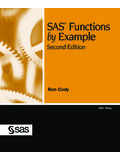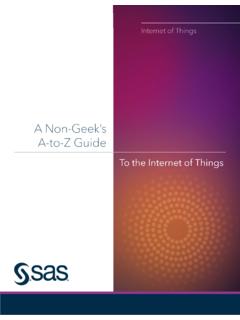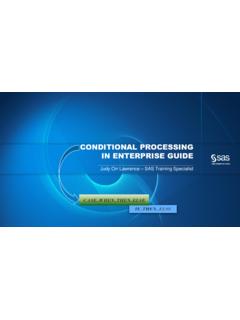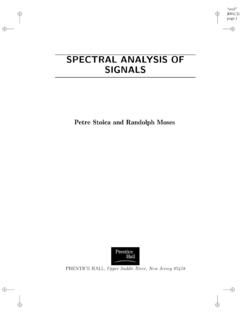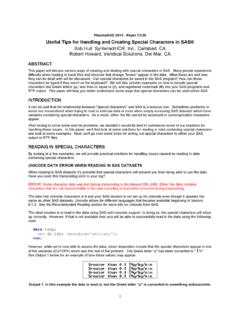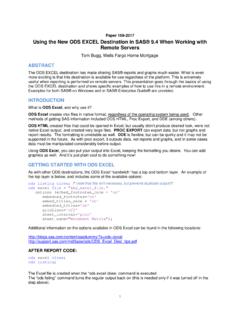Transcription of An Introduction to the ODS Destination for Word - SAS
1 Paper SAS3235-2019. An Introduction to the ODS Destination for Word David W. Kelley, SAS Institute Inc. ABSTRACT. The SAS output delivery system (ODS) Destination for Word enables customers to deliver SAS reports as native Microsoft Word documents. The ODS WORD statement generates reports in the Office Open XML Document (.docx) format, which has been standard in Microsoft Word since 2007. The .docx format uses ZIP compression, which makes for a smaller storage footprint and speedier downloading. ODS WORD is preproduction in the sixth maintenance release of SAS This paper shows you how to make a SAS report with ODS WORD. You learn how to create your report's content (images, tables, and text). You also learn how to customize aspects of your report's presentation (theme and styles). And you learn how to enhance your report with reader-friendly features such as a table of contents and custom page numbering. If you're cutting and pasting your SAS output into Microsoft Word documents, then this paper is especially for you!
2 Introduction . For almost as long as ODS has existed, customers have used it to automatically generate SAS reports as Microsoft Office (Excel, PowerPoint, Word) documents. Prior to Office 2007, Microsoft used proprietary binary formats for these documents. ODS developers worked around the restricted formats by inventing destinations (ODS RTF, ODS , ODS. , ODS ) that generate reports in intermediate text formats (RTF, Excel XML, HTML) ingestible by Word and Excel. This indirect approach has drawbacks. Customers are required, within an Office application, to manually save the generated document in the standard format. The intermediate formats are not as rich as the standard formats, so SAS reporting elements might get lost in translation. For example, Excel XML does not support images, so SAS/GRAPH and ODS. GRAPHICS do not work with ODS And third-party applications do not support the intermediate formats well, if at all. Have you ever tried to view an RTF.
3 Document on an iPad or iPhone? Good luck with that! Microsoft released the Office Open XML file formats in 2007, and they were standardized in 2008. We in ODS R&D knew then that we wanted to build a new suite of destinations for the new Office. We also knew that we wanted to start with PowerPoint, because we had no existing Destination for PowerPoint. We plugged that hole in our lineup with ODS. POWERPOINT, which came out in SAS Three maintenance releases later, we followed up with ODS EXCEL, which has been hugely popular with customers ever since. With SAS , we completed our Office portfolio by adding ODS WORD. While similar to ODS RTF in its user interface (UI), ODS WORD offers new capabilities by virtue of its support of the native Word .docx format. Later we'll explore several of these capabilities, including themes and page numbering. But first we need to learn how to use ODS WORD in a simple SAS program. Crawl before you walk! 1. MUSIC TO MY EARS.
4 This paper focuses on output , specifically ODS WORD output . But we start with input, specifically data for our ODS WORD reports. I wanted data that is derived from real life experience, is unique, and hopefully is interesting. I chose my iTunes music playlist as the input data. A playlist is singular and empirical by nature. It has the potential to be interesting, if for no other reason than to provoke the argument that there is no accounting for taste in music! In my PC iTunes app, I synchronized my iPod and exported the playlist as a text file. Then, using the IMPORT procedure and DATA step, I imported the text file into a SAS data set called Table 1 displays the variables for Variable Type Format Album Char $95. Artist Char $255. Composer Char $118. Date_Added Num DATETIME. Genre Char $18. Last_Played Num DATETIME. Last_Skipped Num DATETIME. Name Char $456. Plays Num BEST12. Skips Num BEST12. Time Num MMSS. Track_Count Num BEST12. Track_Number Num BEST12.
5 Year Char $4. Table 1. ITUNES Variables is a collection of tracks. I know that the tracks are comprised mostly of songs, although there is a scattering of instrumental and spoken word recordings among them. Note that one song might be represented by more than one track. (It could appear on multiple albums and/or have multiple versions.). 2. EASY AS PIE. What types of music are in my playlist? We can answer that question broadly by summarizing the tracks by genre. Here is one way to do that with ODS WORD: ods word file="c:\users\sasdck\onedrive - sas\ ";. title "My iTunes Genres";. proc sgpie data=myitunes;. pie genre / datalabeldisplay=(percent);. run;. ods word close;. Like other ODS destinations , the ODS WORD Destination supports the "ODS sandwich". programming idiom. You sandwich your procedure and DATA steps in ODS WORD. statements. The beginning ODS WORD statement opens an ODS WORD Destination and prepares it to process the procedure and DATA step output .
6 The ending ODS WORD. statement closes the Destination , which terminates the generation of output to the specified file. An open ODS WORD Destination remains open until it is explicitly closed or the SAS. session ends. The FILE= option specifies the output file name. If you do not specify a name, ODS WORD. supplies a default name (typically ). You should always give the file an extension of .docx because that is what Microsoft Windows and Word expect. The code writes the output file to the Microsoft OneDrive directory on my PC. Windows automatically synchronizes files written to that location to my OneDrive cloud storage. This is handy for accessing the files on mobile devices. We will examine that capability in the GO. MOBILE section. The SGPIE procedure generates pie and donut charts. PROC SGPIE is preproduction in SAS. Display 1 below shows the pie chart representation of my playlist genres in desktop Microsoft Word. My music profile is representative of the Baby Boomer generation (1946 to 1964), of which I am a member, barely.
7 Just recently the Millennial generation surpassed the Boomers as the largest generation in the US population. A Millennial's pie chart would look quite different from mine, don't you think? 3. Display 1. iTunes Playlist Genres (Pie Chart). STACKS OF TRACKS. The pie chart is a fine starting point. It invites follow-up questions. How many tracks are there? And what genres comprise the Other category, which is the fourth largest? We can answer those questions with the TABULATE procedure: ods word file="c:\users\sasdck\onedrive - sas\ ";. title "My iTunes Genres";. proc tabulate data=myitunes;. class genre;. table genre="" all="Total", n="Tracks" colpctn="%"/box="Genre";. run;. ods word close;. 4. Display 2 shows the crosstabular representation of my playlist genres. We see that tracks classified as Folk, Jazz, Religious, and Traditional represent the lion's share of the pie chart's Other category. This is 45+65+25+31=166 of 2,659 tracks, or Display 2.
8 ITunes Playlist Genres (Crosstabular Table). The other catch-all genre we will explore further is Soundtrack. Saying that a track is from a soundtrack tells you nothing about what type of music, if any, it represents. And there isn't a variable for subgenre. But we can list the soundtrack albums, and that will tell you all you really need to know. (Well, that and perhaps Wikipedia .). 5. The playlist is structured by track, not album. This means that we must filter the playlist before we can list the albums. We filter with the SORT procedure, and then we list with the ODSLIST procedure: proc sort data=myitunes(keep=album genre where=(genre="Soundtrack")). out=soundtracks nodupkey;. by album;. run;. ods word file="c:\users\sasdck\onedrive - sas\ ";. title "My iTunes Soundtracks";. proc odslist data=soundtracks;. item put(album,$95.)/style={liststyletype=dec imal};. run;. ods word close;. The PROC ODSLIST ITEM statement accepts an expression, which is evaluated for each observation in the input data set.
9 We know from Table 1 to specify a format of $95. to the PUT function for variable Album. By default, lists are unordered (bulleted). I want an ordered list, so I specify LISTSTYLETYPE=DECIMAL as a style attribute override. What are the results? Display 3 tells the tale the listed soundtracks are all musicals. Some are Broadway cast recordings, some are movie soundtracks, and others are not discernible from the album title. The report lists eleven soundtrack albums, but arguably it should be thirteen. My playlist includes the soundtrack to the movie Purple Rain, but iTunes assigns its genre to be R&B. instead of Soundtrack. And the soundtrack to the movie O Brother, Where Art Thou? has no assigned genre at all. Your output is only as good as your input data! Display 3. iTunes Playlist Soundtracks 6. NOW PLAYING. So far, we have explored the types of music in my playlist. But what tracks have been played, and how many times? More specifically, which artists, by genre, have gotten the most plays?
10 A Top N report is tailor-made to answer these types of questions. If you are not familiar with Top N reports, then refer to the SAS Technical Support sample (Creating a Top N. Report) on the subject. My Top N report is adapted from the code in the sample. The main steps of the algorithm are as follows: 1. Summarize the number of plays by genre and artist, and then store the results in output data set 2. Sort so that the top plays by genre appear at the top of output data set 3. Rank the top 10 plays by genre. 4. Print the top 10 artists in plays by genre. In addition, we instruct ODS WORD to automatically generate a clickable table of contents (TOC) for the report. Here is the code for the Top N report: proc means data=myitunes sum noprint;. var plays;. class genre artist;. output out=summary sum=plays genre /levels;. run;. proc sort data=summary out=topn;. where _type_>2;. by genre descending plays;. run;. data topn;. length rank 8;. label rank="Rank".
